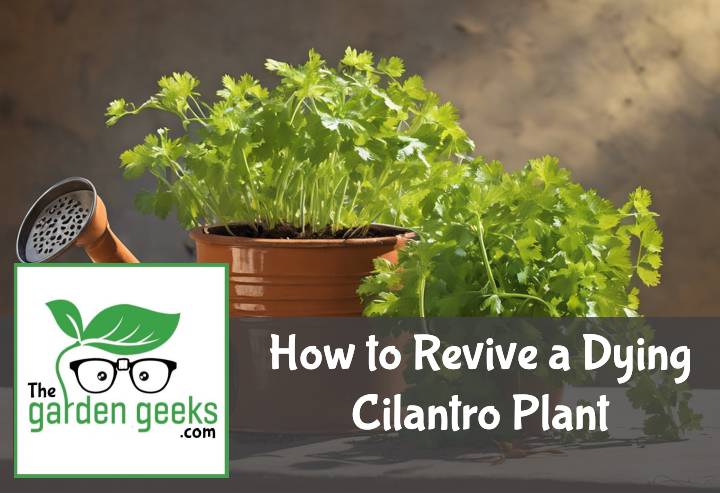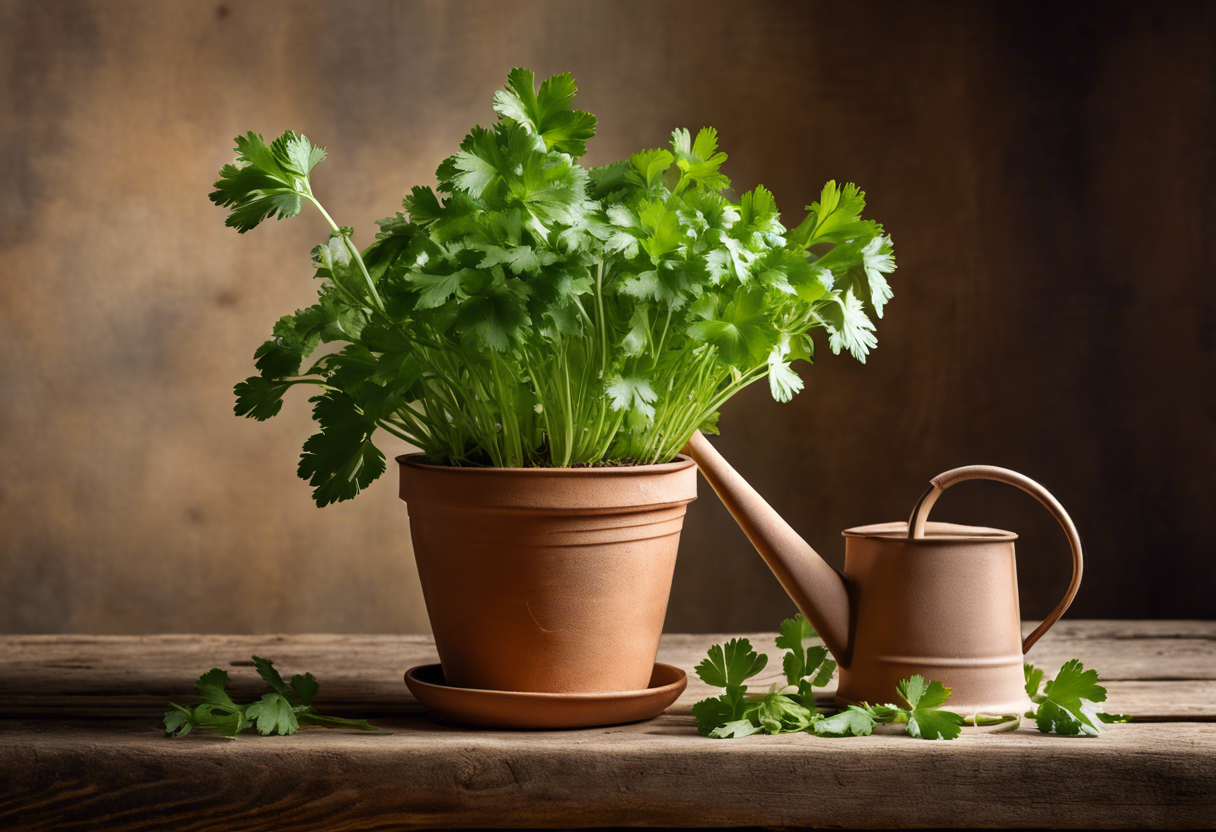You know, there’s nothing quite as heartbreaking as seeing your beloved cilantro plant start to wilt and brown. It’s like watching your favorite character in a TV show meet an untimely end – totally unexpected and utterly disheartening. But don’t lose hope just yet! How to Revive a Dying Cilantro Plant is here to save the day!
So, buckle up green thumbs, it’s time to play doctor for our leafy friend. With some TLC and the right techniques, your cilantro plant could be back to its vibrant self in no time. Keep reading about How to Revive a Dying Cilantro Plant.
Key Takeaways
- Identify the problem with your cilantro plant: overwatering, lack of sunlight, or nutrient deficiency.
- If overwatered, allow soil to dry out before watering again.
- For insufficient sunlight, move the plant to a location that receives 6 hours of sunlight daily.
- Nutrient deficiency can be corrected by adding organic compost or a balanced fertilizer.
- Prune dead leaves and stems regularly to promote new growth.
- Repotting may be necessary if the plant is root-bound.
Understanding Cilantro Plant Health
In the journey of How to Revive a Dying Cilantro Plant, understanding your cilantro’s health is the first step. It’s like being a plant doctor, diagnosing cilantro plant problems and prescribing remedies.
Identifying Signs of a Dying Cilantro Plant
One day, your cilantro might be green and perky, but the next, it could be wilting faster than ice cream on a hot sidewalk. Wilting cilantro leaves are one telltale sign that something’s amiss.
Another symptom of an unhealthy cilantro is color change. If you notice yellowing cilantro leaves, it’s time to put on your detective hat. Similarly, brown spots on cilantro leaves can indicate trouble brewing beneath the surface.
Lastly, keep an eye out for stunted growth. If your cilantro seems to have hit pause on growing taller or wider, it may be crying out for help.
Common Causes for a Dying Cilantro Plant
Now let’s talk about why your cilantro might be throwing in the towel. One common culprit is watering – either too much or too little. Overwatering can drown your plant’s roots while under-watering can leave them parched.
Next up: sunlight. Just like us humans need our vitamin D, plants need their sunbathing time too! Inadequate sunlight can lead to a sad and droopy cilantro.
Pest infestations are another common cause of dying plants. Tiny bugs might seem harmless at first glance, but they’re like mini vampires sucking the life out of your precious greens!
Finally, poor soil conditions can also lead to plant decline. If your soil isn’t providing enough nutrients or has poor drainage capabilities, it could spell disaster for your cilantros.
Assessing the Condition of Your Cilantro Plant
When it comes to How to Revive a Dying Cilantro Plant, the first step is always assessing its condition. This involves checking the cilantro plant health, evaluating your watering practices, and inspecting for any signs of pests or diseases.
Checking the Soil Quality
Now, let’s get down and dirty with soil quality. The survival of your cilantro heavily depends on this. Start by doing a simple soil quality assessment. You’re looking for nutrient-rich soil that’s just right for cilantro.
The pH level also plays a crucial role in cilantro soil requirements. Aim for a slightly acidic to neutral pH level, somewhere between 6.0 and 7.5.
If you find that your soil isn’t up to par, don’t fret! There are ways to improve its quality. Adding organic matter like compost can do wonders in enriching your cilantro’s home.
Evaluating Watering Practices
Water you waiting for? Let’s talk about watering! Cilantro plants have specific watering needs which if not met, can lead to problems.
Overwatering is one such issue, causing root rot and other nasty stuff. On the flip side, underwatering can leave your plant thirsty and wilting.
The trick is finding that sweet spot – not too much, not too little. An optimal watering schedule for cilantro usually involves regular watering while allowing the top inch of soil to dry out between waterings.
Inspecting for Pests and Diseases
Last but definitely not least, we need to play detective and inspect our plant for pests and diseases.
Look out for signs of common culprits like aphids or whiteflies (yuck!). These tiny critters can cause significant damage if left unchecked.
Also keep an eye out for symptoms of common diseases in cilantro plants, like leaf spot or powdery mildew. These can manifest as spots on leaves or a white, powdery substance.
Remember, knowledge is power! Identifying these issues early on is key in the revival process of your cilantro plant.
Reviving Techniques for a Dying Cilantro Plant
When it comes to How to Revive a Dying Cilantro Plant, proper care techniques are your best friends. These include adjusting watering methods, improving soil conditions, and treating pests and diseases. Remember, Cilantro plant care isn’t rocket science, but it does require some know-how.
Adjusting Watering Techniques
First things first, let’s talk water. Both overwatering and underwatering can send your cilantro to plant heaven. So, what’s the sweet spot? Well, optimal watering practices involve keeping the soil moist but not soggy.
Think of it like Goldilocks’ porridge – not too hot, not too cold, just right! If you’re dealing with an already watering dying cilantro, adjust your watering schedule gradually. You don’t want to shock the poor thing even more!
Improving Soil Conditions
Next up on our revival guide is soil conditions. Poor soil can stunt cilantro growth faster than you can say “guacamole!” To improve cilantro soil conditions, consider amending the dirt with organic matter or compost.
This will boost nutrient levels and improve drainage – two things that cilantro absolutely loves! So remember folks, when it comes to healthy soil for cilantro, think rich and well-draining.
Treating Pests and Diseases
Last but certainly not least, we have pests and diseases – every gardener’s worst nightmare. Common culprits include aphids and powdery mildew. But fear not! There are plenty of effective pest treatments for cilantro out there.
For instance, neem oil works wonders against aphids while baking soda spray can help manage powdery mildew. So don’t let these buggers get you down! With a little bit of knowledge (and a lot of patience), you can get your cilantro back on track.
Preventive Measures to Keep Your Cilantro Healthy
When it comes to how to revive a dying cilantro plant, prevention is better than cure. A little TLC can go a long way in ensuring your cilantro stays as green and lively as a spring morning.
Proper Planting and Spacing
You see, planting cilantro isn’t rocket science, but it does require some know-how. Planting cilantro correctly involves giving each little seedling its own personal space. Just like us humans, they don’t like being cramped up!
Proper spacing allows for adequate air circulation which helps prevent diseases. It also ensures each plant gets enough nutrients from the soil. So remember, when it comes to spacing for cilantro plants, more is more!
Regular Fertilization Practices
Next up on our list of cilantro maintenance tips is regular fertilization. Think of fertilizers as multivitamins for your plants. They provide essential nutrients that promote healthy growth and keep diseases at bay.
But be careful not to overdo it! Too much fertilizer can harm your plant more than help it. The key here is balance and consistency in fertilizing cilantro plants regularly.
Optimal Sunlight Exposure
Last but certainly not least, let’s talk about sunlight exposure. Your cilantro needs its daily dose of sunshine for photosynthesis – the process that fuels its growth.
However, too much sun can cause wilting, while too little can stunt growth. Finding that sweet spot of optimal sunlight exposure will ensure your cilantro thrives just right! Remember folks, when it comes to keeping your cilantro healthy, it’s all about balance!
To Wrap Up
Just like reviving a wilting party, How to Revive a Dying Cilantro Plant is all about the right conditions and care. Remember, your cilantro plant isn’t just being dramatic—it’s sending you an SOS!
So, put on your superhero cape, grab your watering can and let’s save that cilantro! After all, what would our tacos do without it?





